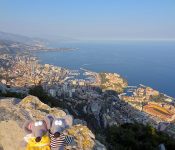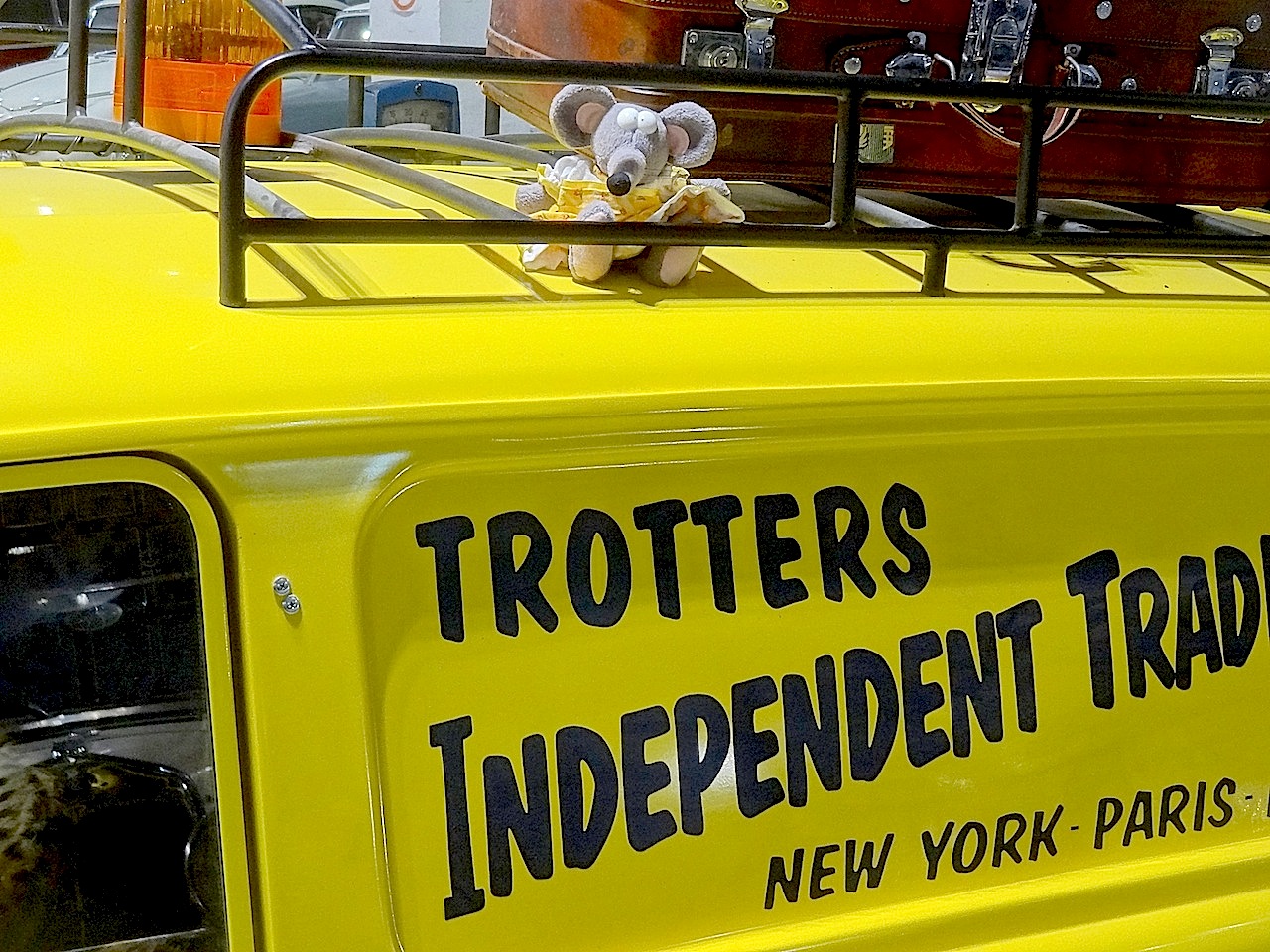The Montmartre hill is one of the most famous, picturesque, and mythical neighborhoods in Paris.
The former municipality of Montmartre merged with Paris during its expansion in 1860. It has been located in the 18th arrondissement of Paris since then.
However, Montmartre offers a unique history and retains many peculiarities, making it an unusual place to visit in Paris.
What are the must-see attractions in Montmartre? What are the things to see and do in the Montmartre district? What to see in Montmartre off the beaten path?
Beyond the few ultra-touristic classics, I present here all the curiosities not to be missed during a visit to Montmartre.
Follow the walking itinerary in Montmartre with the globe-trotting mouse! 🙂
Table of Contents
Map of Montmartre in Paris
Afficher une carte plus grande
How to get to Montmartre
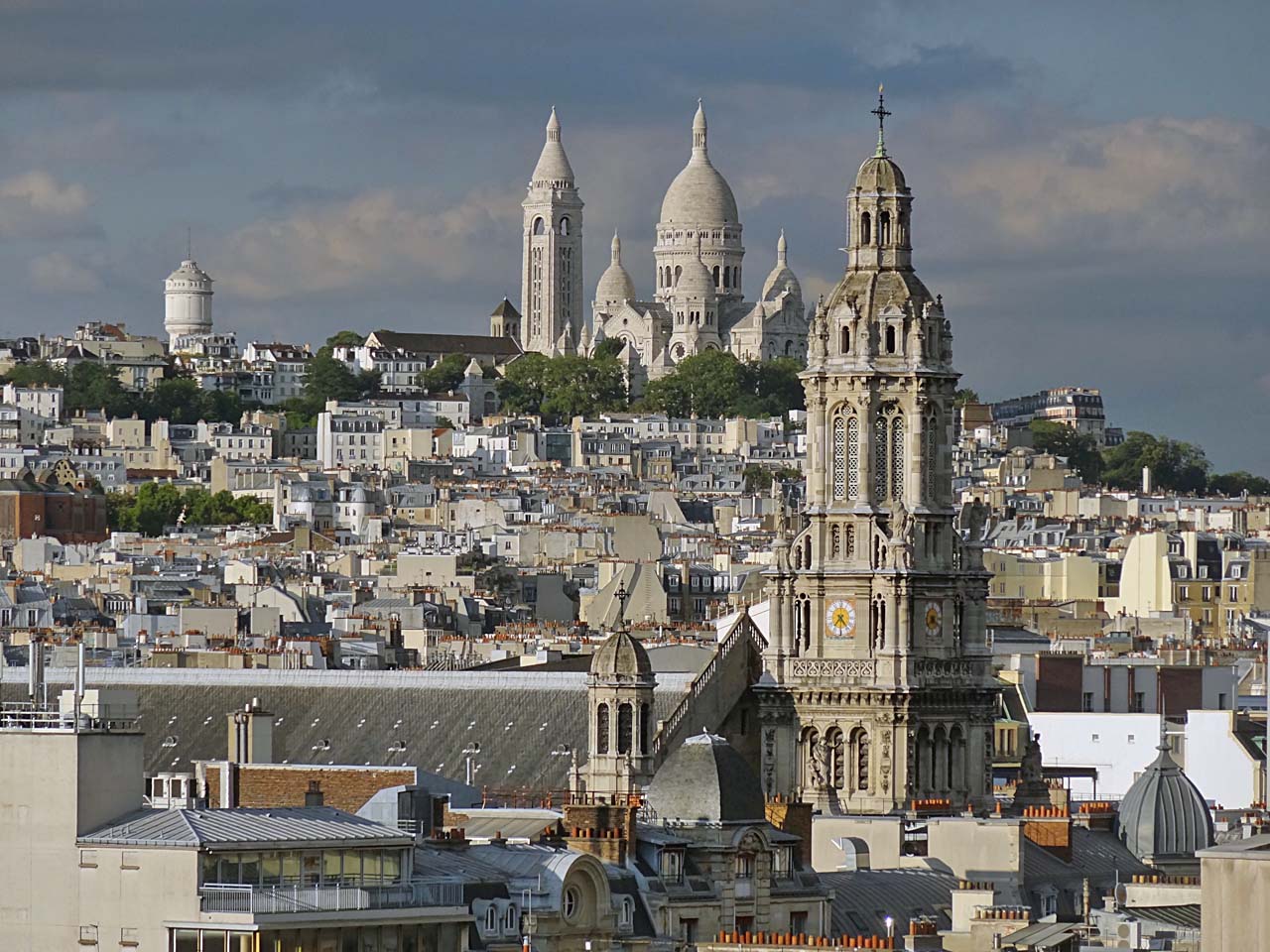
Only metro line 12 serves Montmartre, with two very deep stations: Abbesses and Lamarck-Caulaincourt.
No metro station serves Sacré-Cœur or Place du Tertre, so you will need to walk from these stations.
Alternatively, like most tourists, you can take line 2 to Anvers and then walk up to the top of Montmartre!
If walking is a challenge, note that bus 40 RATP (formerly Montmartrobus) covers most of the streets in Montmartre. You can take the bus and walk only part of the way in Montmartre.

Finally, a tourist train travels the streets of Montmartre. Without getting tired, it shows you the things to see and do in the Montmartre district!
The Montmartre tourist train operates from 10 am to 7 pm during the season (until 5 pm in winter). It departs from Place Blanche, near the Moulin Rouge. The cost is €8 in 2023.
It takes a break at Place du Tertre. This allows you to catch another train later included in the price, giving you time to stroll at the top of Montmartre hill.
Information on the official website of the Montmartre tourist train
Montmartre Funicular
Feeling a bit tired before starting your Montmartre tour? Thankfully, there’s the famous Montmartre funicular!
It ascends the steep slope of Square Louise-Michel, at the foot of Sacré-Cœur, sparing you the famous stairs!

Montmartre Funicular, the only one in Paris (this hasn’t always been the case), is not directly connected to the metro, unlike in Lyon, for example.
You’ll need to alight at Anvers station and walk to the lower funicular station (about 300 meters) via Rue de Steinkerque.
Managed by RATP, similar to buses and the metro, the Montmartre Funicular has a straightforward fare: a regular metro ticket or any usual subscription.

However, you need a separate ticket for the Montmartre Funicular, as there’s no transfer available!
Note: During peak season, expect crowds and potential wait times. Beware of persistent African bracelet sellers at the lower station.
Montmartre’s Story

In the 19th century, Montmartre was a village perched on its hill, north of the boundaries of the Paris of that time.
Pierced with quarries, it had several mills for various uses.
With its steep paths, access was challenging. The village offered low rents, attracting the impoverished: workers, artists, but also a shady crowd in the famous Montmartre maquis.
Montmartre saw the multiplication of guinguettes. Outside of Paris, wine was not subject to the city toll!

At the end of the century, Renoir, Pissarro, Toulouse-Lautrec, and other Impressionist painters stayed in Montmartre. Van Gogh spent two years there with his brother Theo before heading to Arles and later to see Dr. Gachet in Auvers-sur-Oise.
At the turn of the 20th century, Picasso invented Cubism at Bateau-Lavoir, a particularly rustic artists’ studio!
Charles Aznavour, who began his career on Montmartre hill, beautifully captured this bygone era in his song “La Bohème“.
Writers also frequented Montmartre, such as Verlaine and Apollinaire. However, in 1914, war arrived, marking the end of an era.
Artists migrated to the Montparnasse district, which was booming at the time…
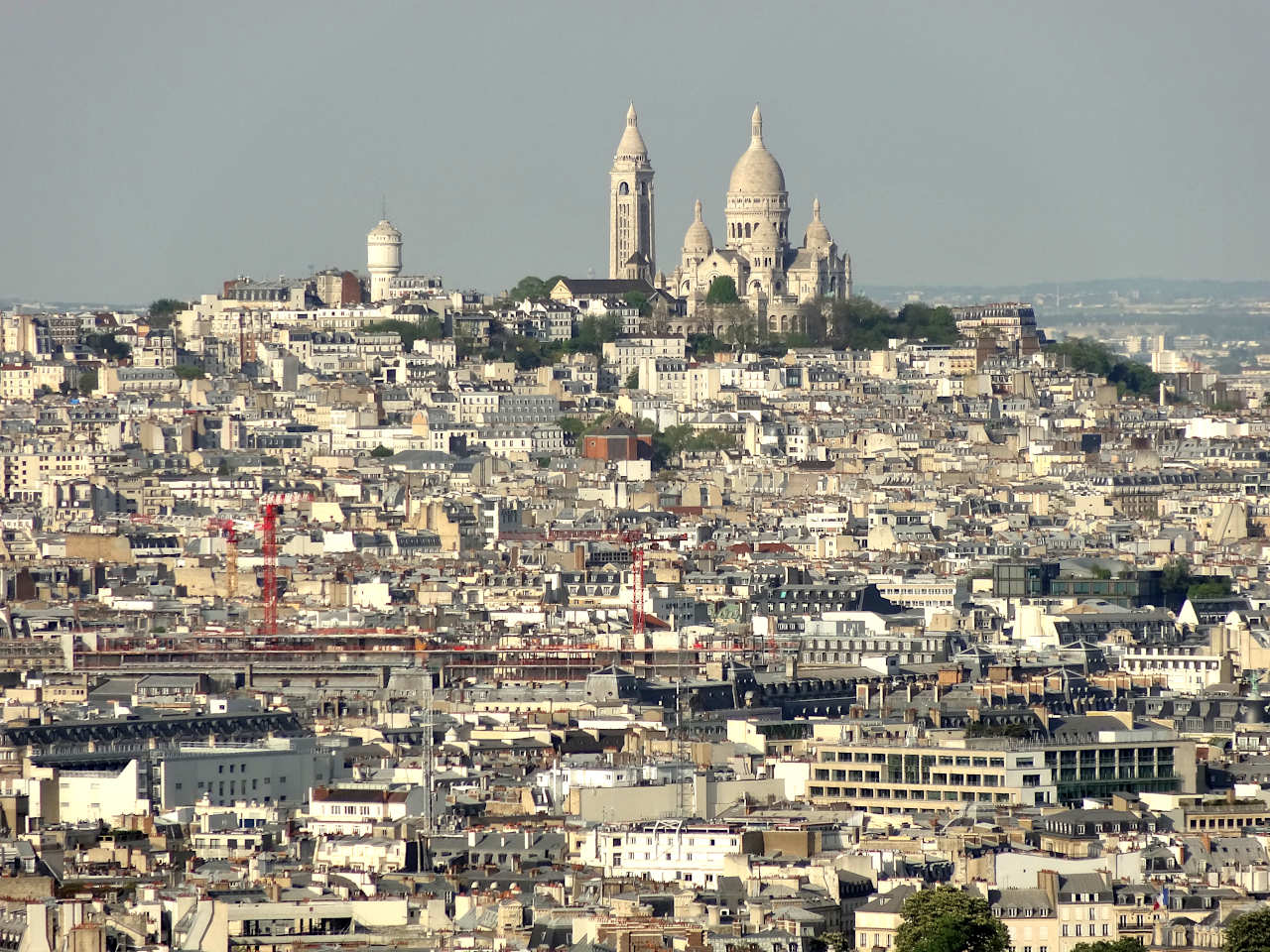
What to do in Montmartre: Unmissable Places
Here are the must-see places in Montmartre, as well as the unusual and lesser-known spots on the hill…
- The Basilica of the Sacred Heart, the imposing pastry that overlooks Paris!
- Saint-Pierre de Montmartre Church and its secret cemetery
- Place du Tertre, with its caricaturists, numerous restaurants, and tourists
- Place du Calvaire, the smallest in Paris, with an exceptional view
- Radet Mill and Blute-Fin Mill, composing the Moulin de la Galette
- Montmartre Museum, full of charm
- Montmartre’s vineyard
- The Castle of Mists
- Place des Abbesses and Saint-Jean de Montmartre Church
- Montmartre Cemetery, resting place for many celebrities
- The Moulin Rouge, one of the most famous cabarets in Paris
How much time to visit Montmartre
How much time to visit Montmartre on foot?
To complete the following itinerary, allow approximately three hours of walking in Montmartre. This is at a leisurely pace, excluding breaks and museum visits.
Plan about an hour to visit the Montmartre Museum and stroll through its garden, excluding a break at the tea salon!
Of course, you can spend much more time, enjoying an escape game or a treasure hunt in Montmartre with children, see below! 😉
You can choose a route between 1 and 3 hours, during the day or in the evening!
Boulevard de Rochechouart

Let’s start our stroll in Montmartre traditionally, at the exit of Anvers metro station! (line 2)
You are here on Boulevard de Rochechouart, just in front of the Elysée-Montmartre and the Trianon (but no, not the one from Versailles!)
The bustling Rue de Steinkerque, lined with tourist shops, leads to the base of Square Louise Michel, at the foot of Montmartre below the Sacré-Cœur.
Well, avoid the shell game players and other “petition signers”; it’s a guaranteed scam!
Halle Saint-Pierre

To the east of the square, the Halle Saint-Pierre no longer houses a market but rather a museum of outsider art and… a gym.
Across the street is the small market district of Saint-Pierre, known for its fabric and sewing shops in Montmartre, around stores like Dreyfus or Reine.
Louise-Michel Square in Montmartre
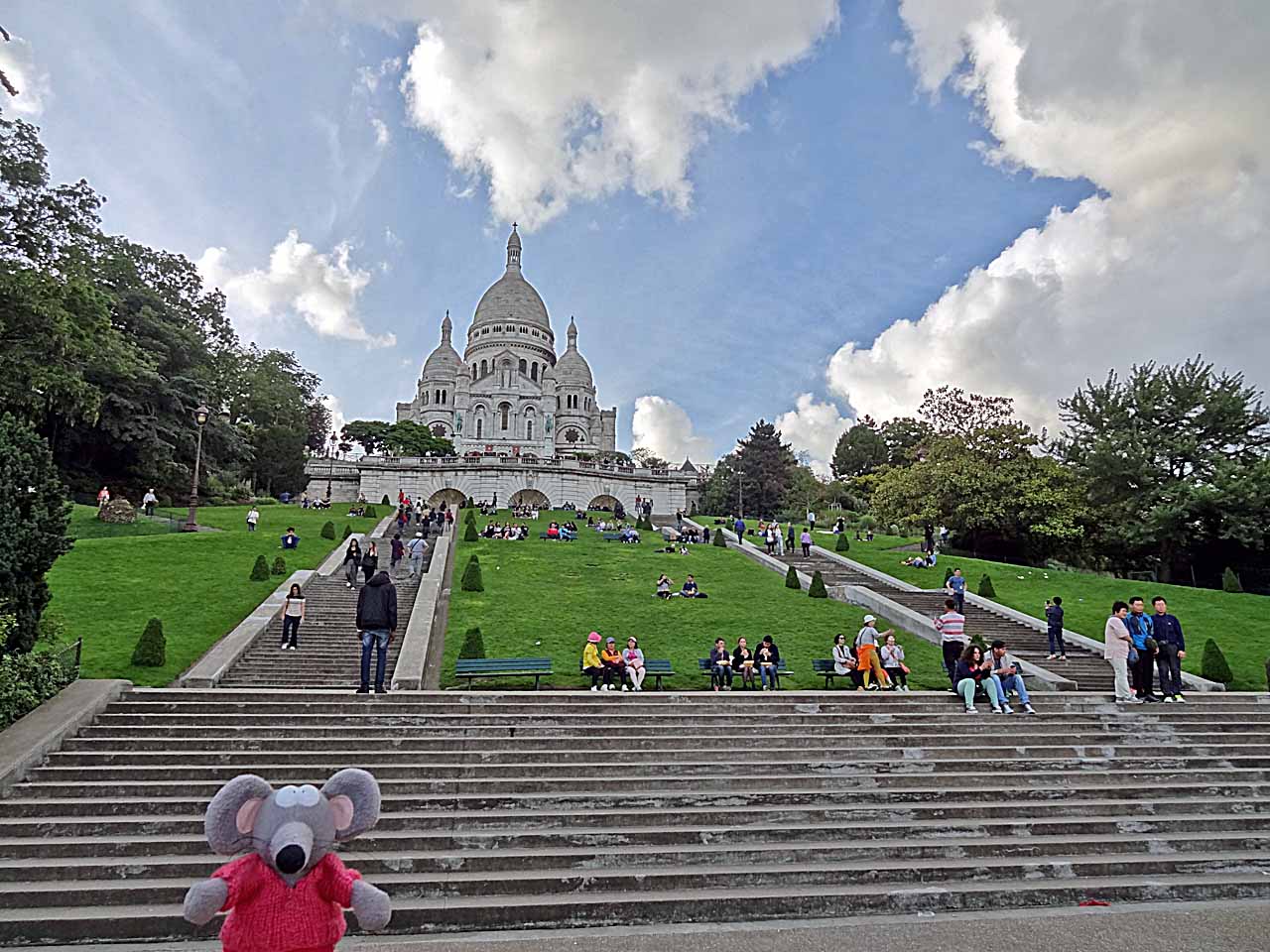
Go back along the base of Square Louise-Michel. Until 2004, it was Square Willette, named after the rebellious Montmartre painter.
However, due to his anti-Semitic ideas, the Paris city hall decided to honor the famous Montmartre Communard instead!
Take a moment to admire the steep slope and the charming Montmartre carousel. Yes, it’s truly steep…

Ah, are you looking for Amélie Poulain’s telephone booth? It didn’t even exist during the film’s time; it’s an idea from Jean-Pierre Jeunet! (Read more below about Amélie’s Montmartre) 🙂
Have a thought for Nino Quincampoix: in the movie, he races up the steps of the square at full speed, only to come down just as quickly!
Don’t take the Montmartre funicular! Admire this curiosity, but if you’re (still) in good shape, climbing on foot will save you from the long queue!
No, follow the mouse, for a leisurely climb up Montmartre with many more discoveries, but on a gentle slope and almost without stairs, I promise! 🙂
Martyrium of Montmartre
Continue straight ahead at the foot of the square, taking Rue Tardieu. Then, continue straight ahead on Rue Yvonne Le Tac.
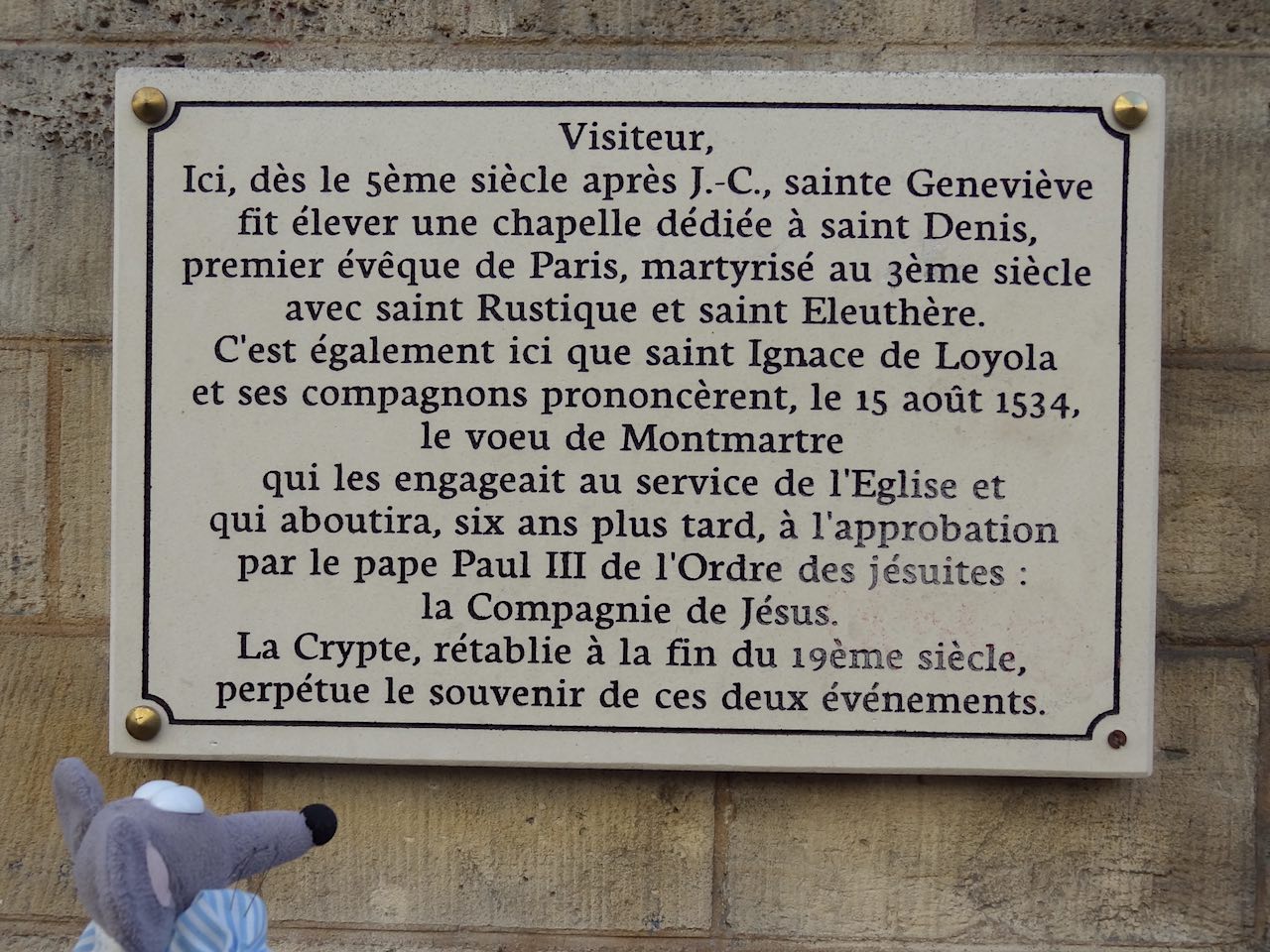
At number 11, a discreet door provides access to the Martyrium of Montmartre, a small underground chapel usually open only on Fridays from 3 pm to 7 pm.
This crypt is located at the supposed site of the martyrdom of Saint Denis and his companions around 250. Destroyed during the Revolution, the current chapel dates back to 1880.
Abbesses Square

You will then reach Place des Abbesses.
It’s the neighborhood of shops and restaurants on Montmartre. Residents and tourists mingle here, maintaining a certain authenticity.
Its name recalls the existence of the former Abbey of Montmartre, which disappeared during the French Revolution.
To the north of the square, Square Jehan Rictus hosts the “Wall of I Love You” (“Mur des je t’aime”). Here, “I love you” is written in dozens of languages!
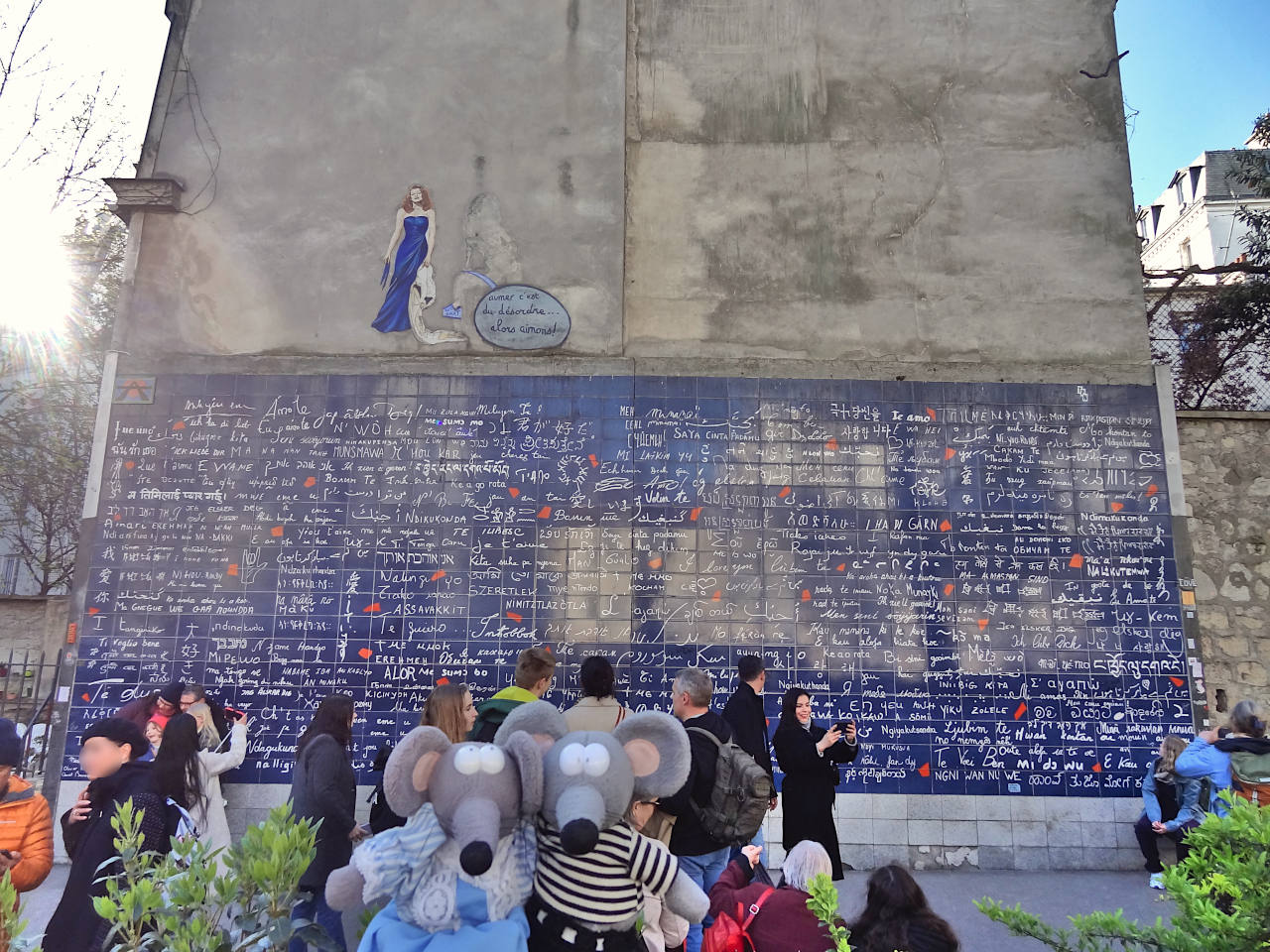
And you, how many languages can you say “I love you” in? Well, you’ll notice that the visit among dozens of tourists is not exactly intimate! 😉
Place des Abbesses is dominated by the church of Saint-Jean-de-Montmartre.
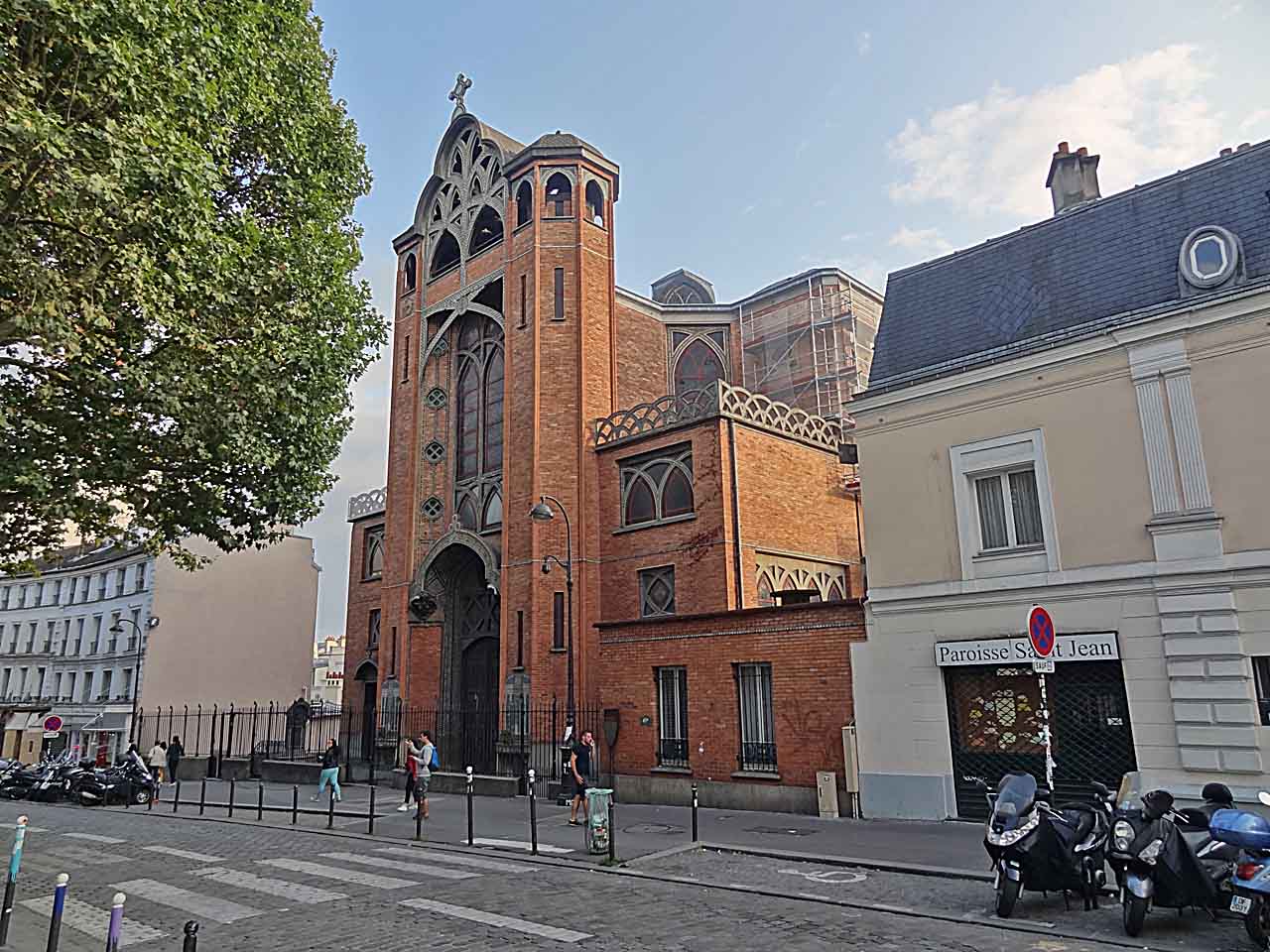
The triangular square houses a Wallace fountain and a beautiful Guimard-designed metro entrance. Well, believe it or not, it was transferred here from the Hôtel de Ville station in the 1970s!
The Abbesses station is on Line 12, once a line of the independent “Nord-Sud” company.
However, the Guimard entrances were those of the CMP, the Paris Metropolitan Company. Moving this entrance here was, therefore, a historical inconsistency!
Yes, until nationalization and the creation of the RATP in 1949, the Paris Metro was private and divided into two companies…
The brave can go down and then walk up using the two staircases of the station. They have been decorated since 2007 with lovely frescoes illustrating Montmartre!
Oh, I forgot: it’s the deepest station in the Parisian network, with platforms located 35 meters below the surface… 😉
Saint-Jean-de-Montmartre Church (église Saint-Jean-de-Montmartre)

The Saint-Jean-de-Montmartre church is nicknamed Saint-Jean des Briques, guess why!
This unique church, built in the Art Nouveau style with a concrete structure, is one of the main landmarks to visit in Montmartre.


Feel free to open the door and explore the inside, quite unconventional for a church. Marvel at the details!


To the right of the choir, don’t hesitate to push the small door of the adjoining chapel!
There, you will find a beautiful monumental door made of bronze and titanium, originally intended for the Sainte-Anne chapel on Rue de Clignancourt!
Just behind the apse of the church, the famous french singer Claude François lived in Montmartre for a while, at 3 Rue Véron…

Let’s continue our walk through Montmartre by heading across the square Jehan Rictus.
At the back, the garden of the Abbesses provides a discreet entrance to the Passage des Abbesses.

Turn right, climb a few stairs, and just 30 meters away, you’ll emerge on Rue des Trois-Frères.
Épicerie Collignon

On the corner, this greengrocer looks familiar… it’s the Collignon grocery store from the movie Amélie Poulain!
In reality, “Au marché de la butte” keeps memories of the film displayed in the shop windows. Amélie lived just above, on Rue Androuet. If you happen to see her, say hello! 🙂
Emile Goudeau Square and the bateau-Lavoir in Montmartre

Take a left on Rue des Trois-Frères, along the grocery store, and in less than 30 meters, you’ll reach Place Émile-Goudeau.
This charming tree-lined square hosts on the left the Bateau-Lavoir, the most famous artists’ studio in Montmartre, where Raoul Dufy and Pablo Picasso painted.
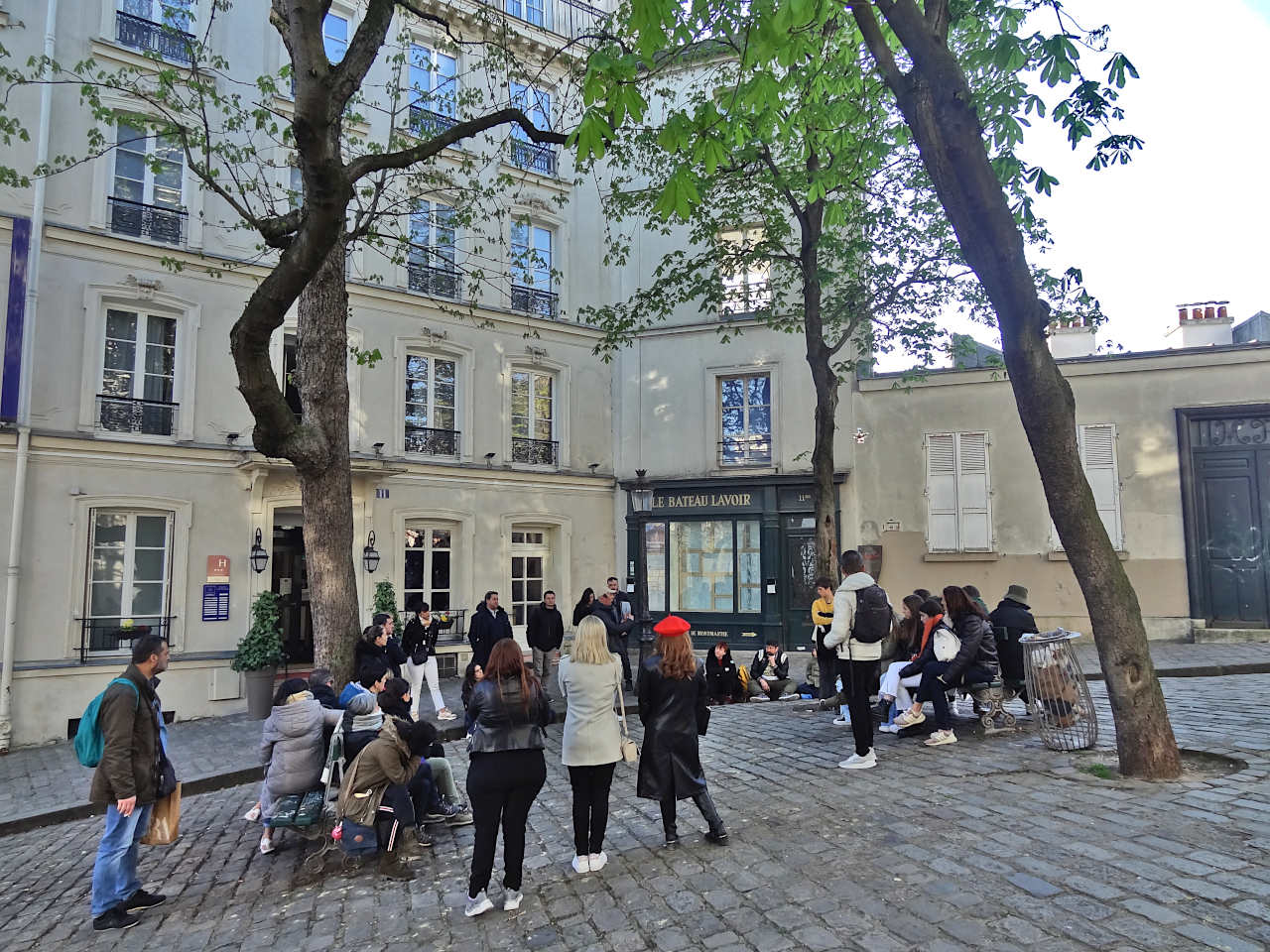
The Bateau-Lavoir unfortunately disappeared in a fire in 1970, but it was rebuilt identically a few years later. It still hosts artists’ studios.
You can catch a glimpse of them from the Louise-Weber-dite-La-Goulue garden by going around through Rue Garreau (below the square) and turning right into the small Rue Burq.

At the top of the square (yes, it climbs a bit there…), you will emerge onto Rue Ravignan.
Orchampt Street: Dalida’s house
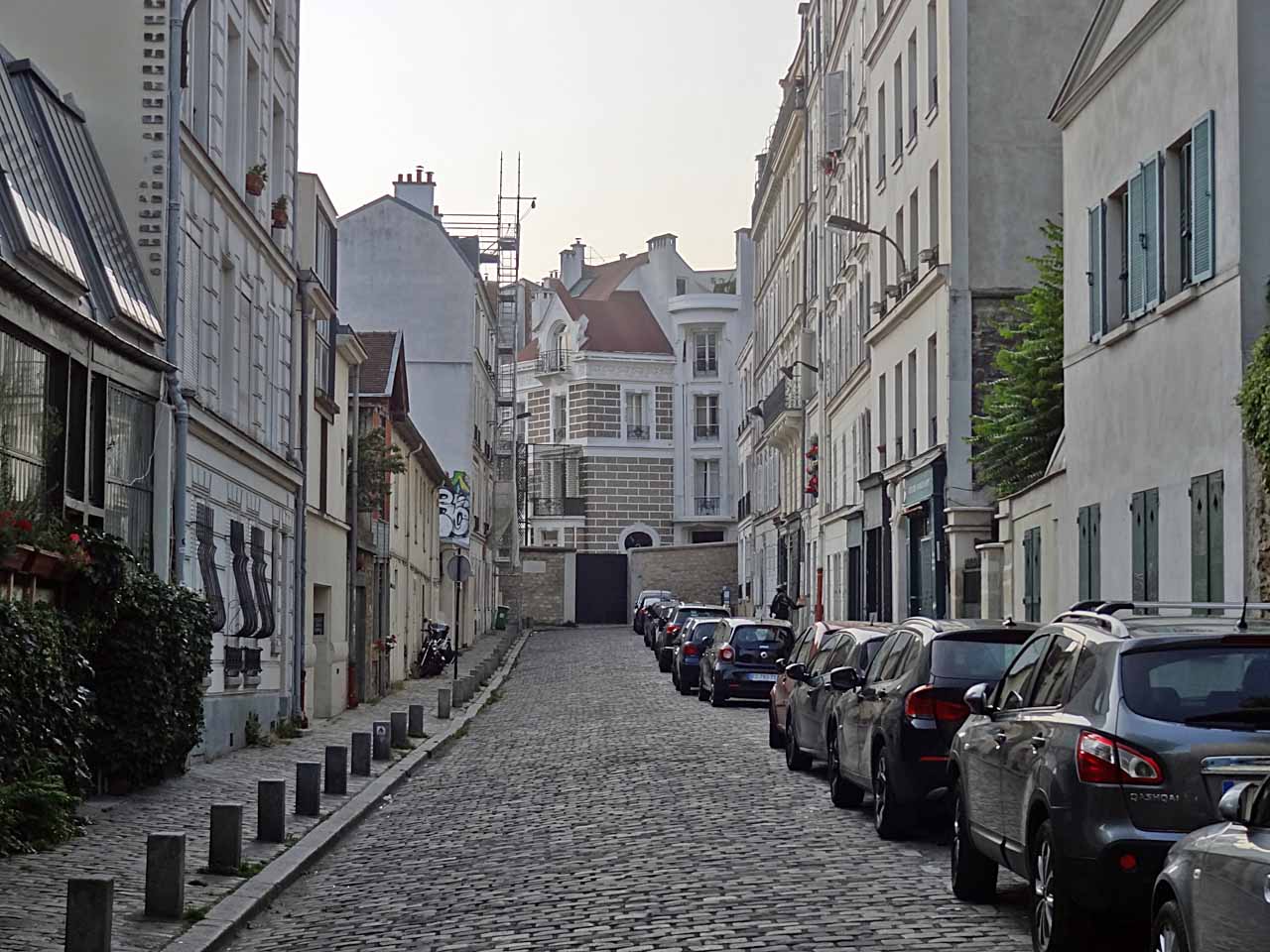
Take a look to the left: it’s Rue d’Orchant, with at the end, in the axis of the street, at n°11bis, the house of the french singer Dalida.
You can go see it (it’s private), but you’ll pass by it again a little later during the walk.
You won’t be able to enter: the house was sold and divided into apartments after the singer’s tragic disappearance.
The famous singer lived here in Montmartre for nearly 25 years until her dramatic death in 1987… in the same house where the writer Céline also lived from 1929 to 1944!
Place Jean-Baptiste Clément
Follow Rue Ravignan for 50 meters: you’re at the foot of Place Jean-Baptiste Clément. Midway, Rue de la Mire reminds us that the Paris meridian passes through Montmartre.
As you pass by, take a look at 49 Rue Gabrielle: it’s here, on the second floor, that in 1900 an unknown Spanish painter settled in Paris: Pablo Picasso.
Jean-Baptiste Clément was the short-lived mayor of the 18th arrondissement during the Paris Commune in 1871.
A unionist, a Communard, but also a songwriter, he is the author of the famous song “Le Temps des Cerises.” With its ambiguous lyrics, it is associated with the popular revolt of the Commune, even though the song predates it by five years.
At number 10, a bas-relief depicts the “Tour Montmartre,” a former guinguette (a type of establishment serving drinks and often offering music and dancing) that disappeared.
Victim of a subsidence, it was located in the center of the current square. Given the instability of the terrain, nothing was rebuilt at that location!

The square sees the upper end of Rue Lepic to the left. But let’s climb a little more: we’re now on Rue Norvins!
To the left, this curious octagonal building is the former water tower of Montmartre.

Built in 1835 when the sources supplying the village ran dry, it now houses the headquarters of the Commanderie de Montmartre.
This association celebrates the Montmartre grape harvest every year!

At the top of the square, you will reach Rue Norvins.
Rue Norvins
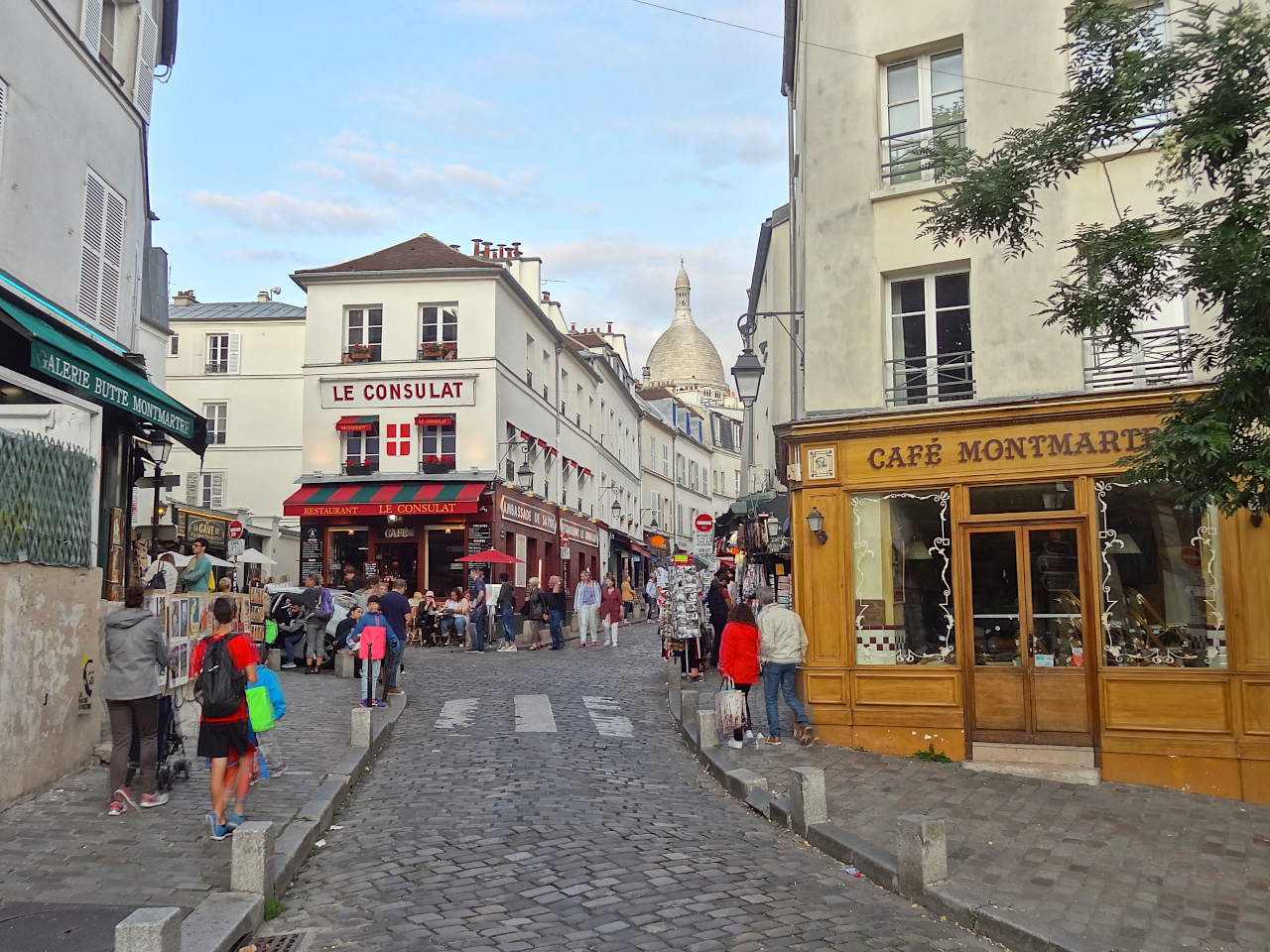
Rue Norvins is the liveliest street at the top of Montmartre hill, with numerous shops… for tourists.
Here, you’ll find some snack bars and restaurants, along with a Starbucks coffee.
It provides our American tourist friends with a good coffee reminiscent of across the Atlantic! (I see an Italian reader choking, strange!) 😉
At the beginning of the street, Rue des Saules starts, and nearby is the cabaret La Bonne Franquette.
In the late 19th century, it was frequented by the Impressionist painters. Van Gogh painted “The Guinguette at Montmartre” here in 1886.
Place du Tertre

Rue Norvins opens onto the famous Place du Tertre, the must-visit spot in Montmartre!
Here, caricaturists reign supreme amidst the increasingly crowded restaurant terraces.

I haven’t availed myself of their services, lacking a too caricatural appearance.
It’s less crowded in winter, with a completely different atmosphere.

Note the famous restaurants on Place du Tertre, such as La Mère Catherine or its neighbor, Au Cadet de Gascogne.
Easily attracting tourists in search of genuine-fake authenticity, the quality may not necessarily be commensurate with the prices displayed…
Head to the back of the square to the right, passing by Chez Eugène and Le Sabot Rouge. You’ll reach Place du Calvaire, the smallest square in Paris!
Place du Calvaire

Small but essential in Montmartre! Place du Calvaire offers a vast panorama of Paris.
It houses the Dali Space, the only museum dedicated to the artist Salvador Dali in France.

The square also houses the restaurant Chez Plumeau, which became inadvertently famous in its own way! It was here that the “saccage Paris” movement on Twitter was born in 2021!
This Montmartre restaurant was renowned for its beautiful wisteria, which served as a natural arbor during the warmer months.
However, taking advantage of the lockdown, the Paris City Hall, known for its penchant for cutting, decided to destroy this old centennial wisteria, supposedly sick…
Whether true or not, the ordeal of the wisteria is just a sad symbol, among many others, of the methodical destruction of Parisian aesthetics. This destruction led to a widespread protest movement in Paris.
The square leads to Rue Poulbot, named after the artist famous for his paintings depicting the poor children of Montmartre.

Retrace your steps and cross the Place du Tertre. You will emerge onto Place Jean Marais.
Place Jean Marais

Place Jean Marais pays tribute to the famous French actor, painter, and sculptor, a resident of Montmartre who passed away in 1998.
You are now among many tourists in front of the unassuming facade of the Saint-Pierre de Montmartre church.
Church of Saint-Pierre de Montmartre (Église Saint-Pierre de Montmartre)

Among the must-see attractions in Montmartre, don’t miss the Saint-Pierre de Montmartre church!
The classic and understated facade of Saint-Pierre de Montmartre conceals one of the most interesting Gothic churches in Paris.
On the left side of the church’s forecourt, take note of the Cottin Cross. Dating back to the 18th century, it was relocated here after the closure of an old cemetery in Chapelle-Saint-Denis, a former commune merged with Paris in 1860.
Inside, just as you enter, observe two columns that appear much older than the others. These are remnants of the Temple of Mars, which crowned the Montmartre hill during ancient times!
Calvary Cemetery: an Unusual and Secret Place in Montmartre

On the left of the church’s facade, behind a beautifully carved bronze door, hides a secret and unusual place in Montmartre!
The Calvaire Cemetery, officially named the Saint-Pierre-du-Calvaire Cemetery, is a particularly unknown spot in Paris.
And for a good reason: this cemetery, measuring only 600 square meters, opens only once a year, on November 1st, All Saints’ Day!
Despite its location in one of the most famous and touristy neighborhoods in the capital, it is probably the most secretive cemetery in Paris.
Well, it is theoretically possible to enter the Calvaire Cemetery on two other occasions: during the Heritage Days (the third weekend of September) and during the Garden Festival.
But that’s still very limited, and most Parisians have never visited this unusual place.
Instead of sticking your nose through the gate to catch a glimpse, the globe-trotting mouse, a fan of unique places and tranquil cemeteries, reveals it to you in photos… 😉
History of Calvary Cemetery in Montmartre
The Calvaire Cemetery in Montmartre gets its name from a Calvary erected in the adjoining garden.
It is one of the oldest still existing in Paris, the smallest with less than 600 square meters, and the only one, along with the one in Charonne, still surrounding a parish church.
Opened at the end of the 17th century on the site of an ancient Merovingian necropolis, it was closed during the Revolution. All the tombs disappeared at that time, including the burial site of the sculptor Pigalle, who died in 1785.
The Calvaire Cemetery was eventually reopened from 1801 to 1831, the year the Saint-Vincent Cemetery in Montmartre opened. No more burials took place there since then, except for the descendants of those already buried here.
Buried at the Calvary Cemetery in Montmartre
Entering the Calvaire Cemetery, enclosed by high walls, is through the heavy bronze gate known as the Gate of the Resurrection. It is a work dating back to 1980 by the Italian sculptor Tommaso Gismondi (1906-2003).
The 85 remaining tombs mostly belong to Montmartre families and many are those of nobles from the lower part of Montmartre who emigrated during the French Revolution.
Among them, notable graves include those of the navigator Louis-Antoine de Bougainville (1729–1811), his wife, and son (grave no. 65), and Félix Desportes, the first mayor of Montmartre in 1790 (grave no. 43).
There is also the grave of the Debray miller family (grave no. 32), the founders of the famous “Moulin de la Galette,” a dance hall immortalized by Renoir and later by Utrillo.
A mass grave holds the remains of hundreds of French and foreign soldiers who fell in March 1814 during the Allies’ capture of Paris, united against Napoleon.
You can find a detailed map in PDF format of the cemetery on the official website of the City of Paris.
If you’re not fortunate enough to visit during the right dates, there’s still a way to get a glimpse of Calvary Cemetery in Montmartre!
Climb to the top of the Sacré-Cœur dome, offering an exceptional panoramic view of Paris and its surroundings… and the Calvary Cemetery just below! 😉
Now, let’s continue our Montmartre exploration on foot! Go around the Montmartre reservoir, located south of the church.
You’ll overlook Nadar Square, with its statue of the Chevalier de la Barre, and the upper station of the funicular before reaching the forecourt of the Sacré-Cœur.
Basilica of the Sacré-Cœur in Montmartre

The Basilica of the Sacré-Cœur in Montmartre was built from 1873 to atone for the sins of the Paris Commune – quite a mission!
In truth, the unstable ground from Montmartre’s quarries made the undertaking delicate.
Designed by architect Paul Abadie, drawing inspiration from the Saint-Front Cathedral in Périgueux, the cornerstone was symbolically laid in 1875. However, the building was only completed and consecrated in… 1919!
The church takes the form of a Greek cross crowned with four domes.

Today, this grand pastry is the second most visited religious building in France after Notre-Dame de Paris!
Inside the Sacré-Cœur
Inside the Sacré-Cœur, quite understated, observe the immense mosaic in the choir.
It depicts the resurrected Christ dressed in white, with a golden heart. Covering 475 square meters, it’s the largest mosaic in France!

The church stays white without renovation, but by what mystery? Rainwater whitens the stone, bringing out the white calcite!
The expansive crypt of the Sacré-Cœur once hosted a scenography but has been closed since 2021. One can also notice the offerings of the faithful.
The basilica is freely open every day, all year round, from 6:30 AM to 10:00 PM.
View of Paris from the dome of the Sacré-Cœur
Access the Sacré-Cœur dome from the outside, on the left side of the building.
It provides a remarkable 360° panorama of Paris and its nearby northern suburbs. But you’ll also notice the hidden gardens of Montmartre, behind tall walls…
Well, there’s no elevator, get ready to climb nearly 300 steps! 😉

Upon exiting, surely admire the beautiful panorama of central Paris from the forecourt.
You can see (unfortunately…) the Montparnasse Tower, but not the Eiffel Tower, it’s too far west!
Afterwards, take a stroll around the basilica to appreciate its architecture.
Rue du Chevalier-de-la-Barre

After passing the apse, you’ll notice the beautiful Gothic apse of the church of Saint-Pierre-de-Montmartre, in its small garden.
Follow Rue du Chevalier-de-la-Barre, with its tourist shops.

In 1766, Chevalier de la Barre was tortured and beheaded at the age of 20 for refusing to kneel and remove his hat during a religious procession!
His body was thrown into the pyre with a copy of Voltaire’s Philosophical Dictionary nailed to his chest!
This terrible symbol of religious intolerance was honored here in Montmartre. He is the last person condemned to death for blasphemy in France. Unfortunately, elsewhere in the world…
The street that honors him in Paris is an atypical one in Montmartre. It is a completely winding street interspersed with stairs!
Rue du Mont-Cenis

The western part of the street leads back to Rue du Mont-Cenis, with its shops and art galleries.
Right in front of you, in the axis of the street, at 13 Rue du Mont-Cenis, there is a gallery. However, the place used to host the Patachou cabaret, where Brassens or Aznavour began their careers!
It is also here in Montmartre that Edith Piaf made her last public appearance…
Turn left towards Place Jean-Marais, and 30 meters away, notice on the right the small Rue Saint-Rustique, with its low houses.

Nothing special except that it has no shops! (phew)
This village street in the Montmartre village has thus preserved its authenticity. It is located at 130 meters above sea level, just the highest street in Paris!
Go back and admire the new Montmartre water tower, dating from 1927, as you pass.

Rue du Mont-Cenis ends in stairs descending from the northern side of Montmartre.
In the distance, you can see the Saint-Denis plain and the Stade de France…

Let’s continue our walk on foot through the small streets of Montmartre! Then turn left into Rue Cortot.
Look up at No. 1: a balcony on the building depicts a hen brooding its eggs!
Rue Cortot is also one of the most beautiful streets in Montmartre!
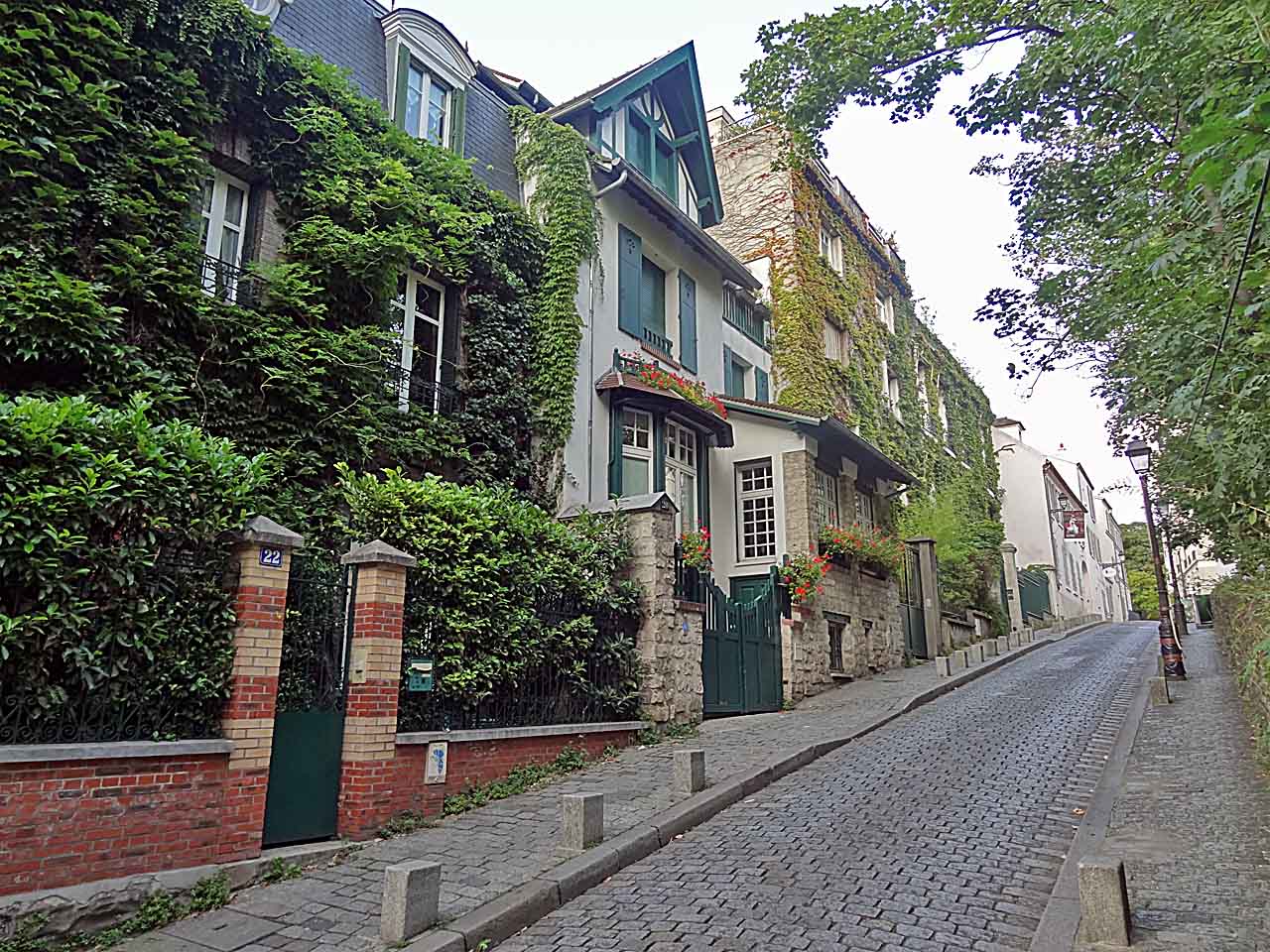

Montmartre Museum
At 12 Rue Cortot, on your right, stands the Maison du Bel Air, built in the 17th century.
It is the oldest house in Montmartre!

It hosted Renoir’s studio, where he painted the famous canvas “Moulin de la Galette” in 1876 (now exhibited at the Musée d’Orsay).
The house now houses the Montmartre Museum.

It recounts the history of the hill and its vibrant artistic life, from Saint Denis to the artists who made its fame, not forgetting the Paris Commune.

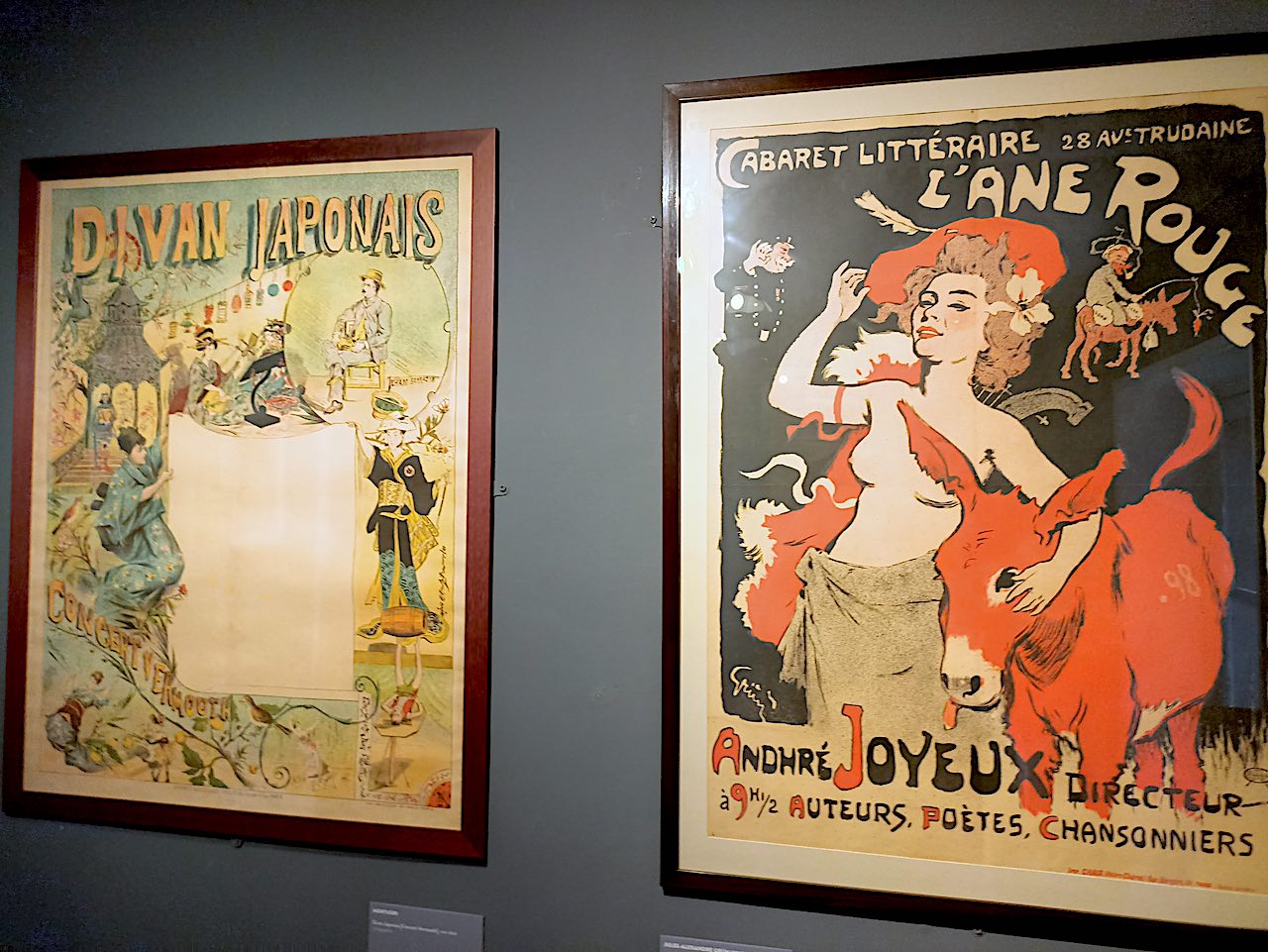

The museum also hosts the studios of Suzanne Valadon and her son Maurice Utrillo.


Enjoy the small garden with a view and the outdoor tea room in season! 😉



Practical information on the official website of the Montmartre Museum
Rue de l’Abreuvoir
At the end of the street, you will emerge onto Rue des Saules, at the intersection of Rue de l’Abreuvoir, one of the most photogenic streets in Paris!

Opposite, you’ll find the famous pink house, painted by Maurice Utrillo!

Montmartre Vineyards

Turn right and go down Rue des Saules. You’ll then pass along the famous Montmartre vineyard!


At the crossroads, you’ll arrive in front of the famous cabaret Lapin Agile, facing the wall of the Saint-Vincent Cemetery.
It has been repainted recently; notice the difference!

It’s one of the oldest cabarets in Paris, frequented by many artists, painters, and writers: Renoir, Modigliani, Picasso, Verlaine, Apollinaire…
The famous sign featuring a rabbit leaping out of a pot with its bottle was drawn by the caricaturist André Gill. Hence the new reputation of the former cabaret des Assassins under the name Lapin Agile!

Take a short detour to the right on Rue Saint-Vincent, at the foot of the vineyards. Every year around mid-October, the vineyards of Montmartre host the harvest festival.
The bucolic setting, between low houses and gardens, is very different from the Haussmannian alignments of Paris!

Right after the vineyard of Clos Montmartre, you reach the bottom of the garden of the Montmartre Museum, and then the wild garden of Saint-Vincent.
Reserved for critters and wild greenery, it is open to visitors only exceptionally.
Saint-Vincent Cemetery
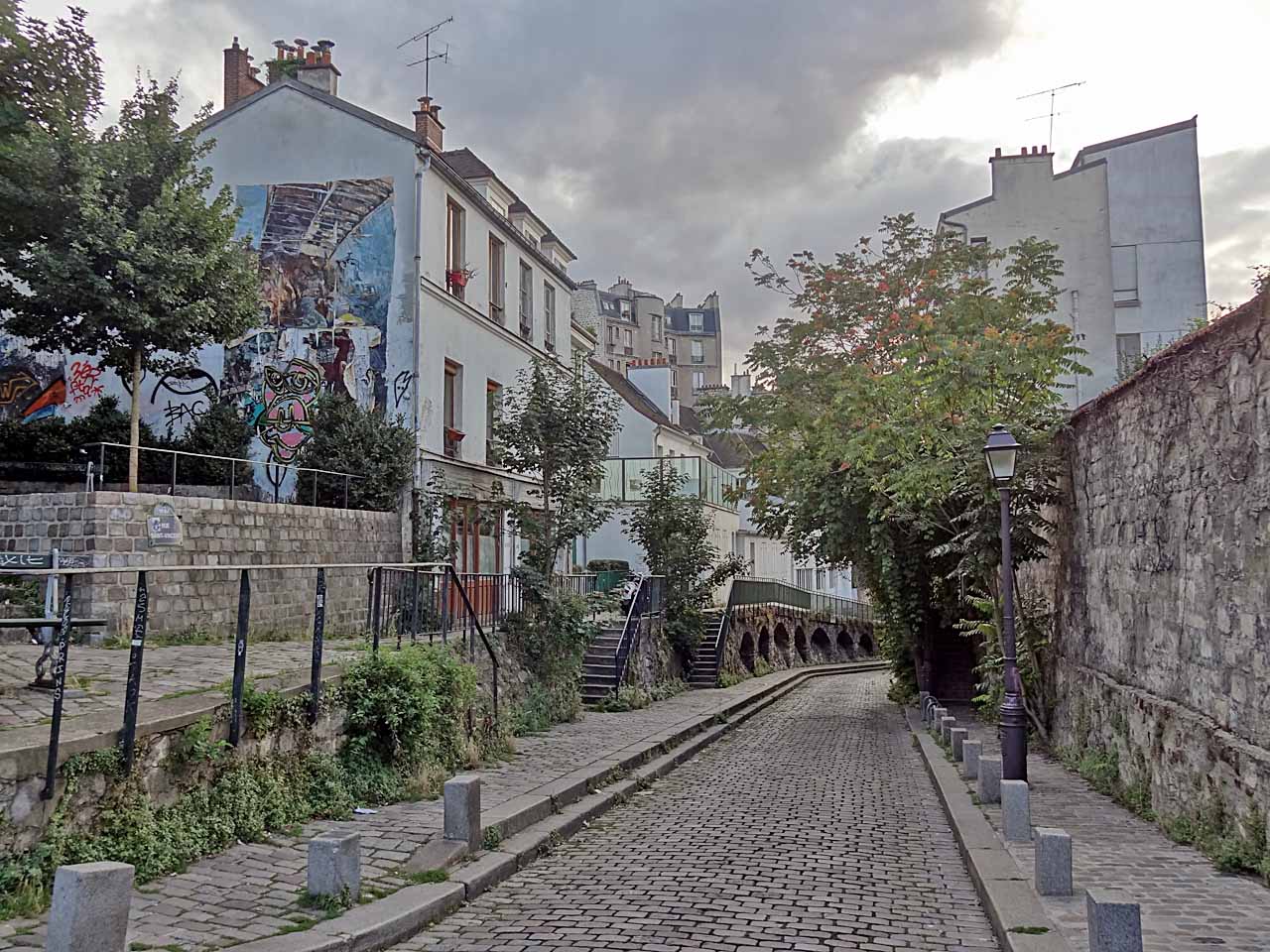
Retrace your steps and follow Rue Saint-Vincent westward. You will then walk alongside the wall of the Saint-Vincent Cemetery.
It is in this bucolic street that the film “Amélie Poulain” begins…
At No. 35, facing the cemetery wall, this is also where the intricate story of the film “The Man in the Raincoat” with Fernandel begins!
Rue Cortot opens onto Rue Constantin-Pecqueur. Turn left going up.
On the right, you descend to Rue Caulaincourt and the entrance of the Saint-Vincent Cemetery.
100 meters away, behind the building at 73 Rue Caulaincourt, hides a former Bavarian pavilion from the 1867 World Expo. This surprising place became the Cat’s Cottage!
Place Dalida

The stairs of Rue Girardon lead to Place Dalida, adorned with a bust of the famous singer.
The bust of Dalida, a work by the French sculptor Aslan, was inaugurated in 1997, ten years after the singer’s passing.
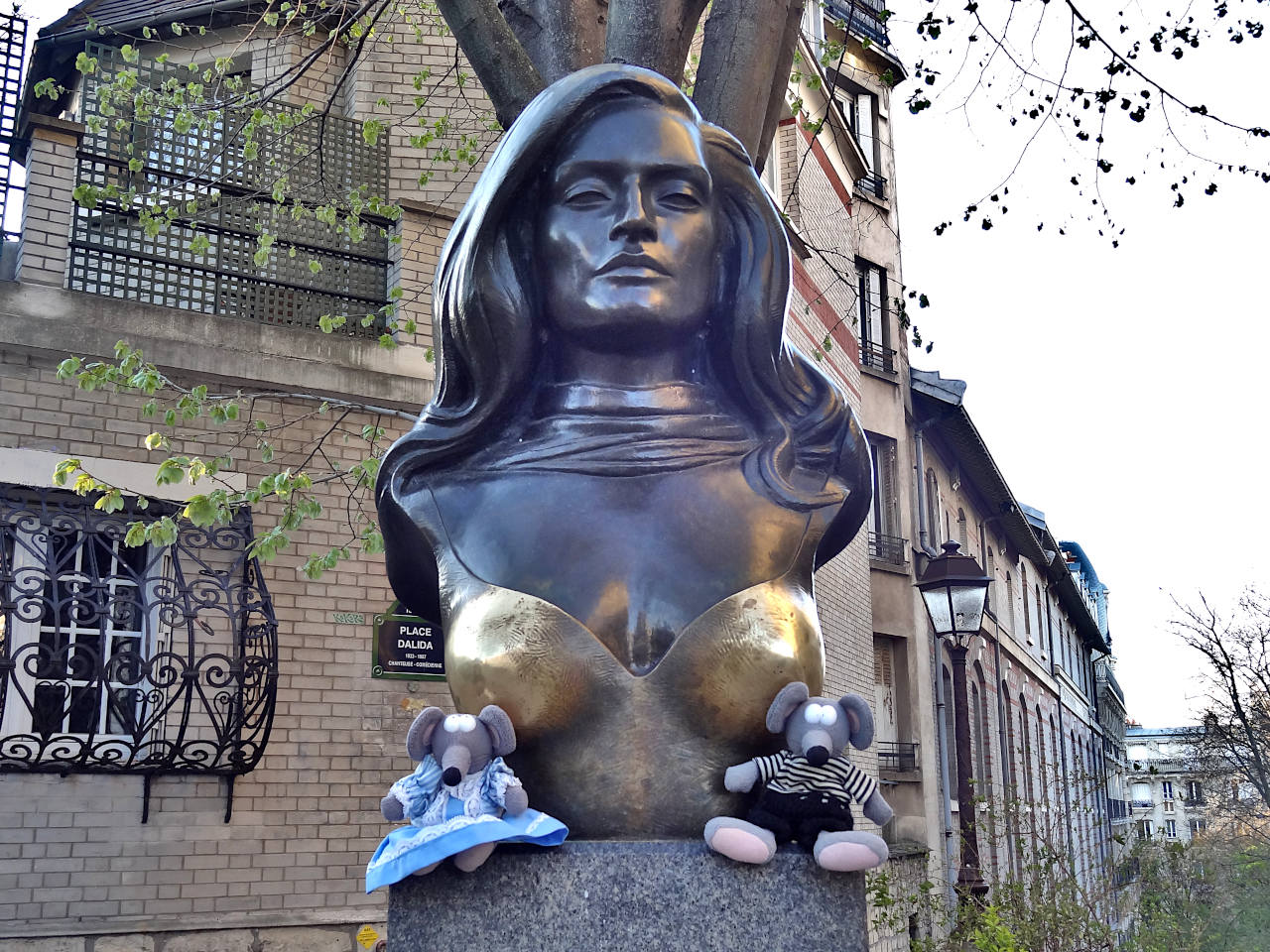
Rue de l’Abreuvoir leads back towards the vineyards. From here, you’ll get THE picturesque postcard image of Montmartre, with a view of the Sacré-Cœur (and the inevitable Parisian construction barriers!)
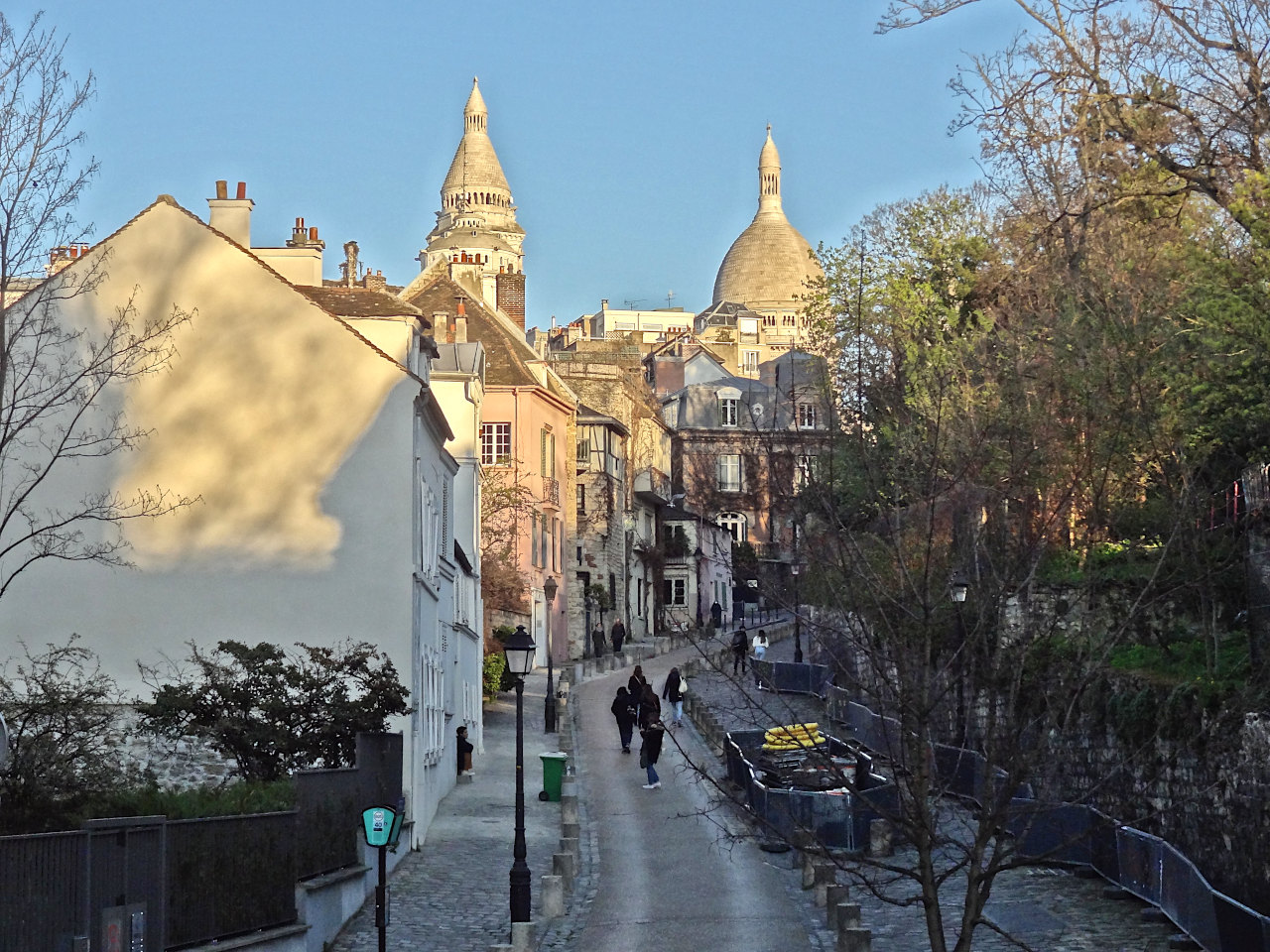
A charming house on the street is adorned with a sundial. Let’s go in the other direction!
Allée des Brouillards (Alley of the Mists)
Turn right into the Alley of the Mists. It runs alongside the garden of the Château des Brouillards.

Cross Place Casadesus but don’t continue straight on Rue Simon Dereure.
On the left side of the square, Square Suzanne Buisson leads to the top of Avenue Junot.
Here, you’ll find a statue of Saint-Denis, a Christian martyr beheaded at the top of Montmartre hill in the 3rd century.
According to legend, he walked away carrying his head under his arm before collapsing six kilometers to the north!
At this spot, the Basilique Saint-Denis was erected…
Avenue Junot
We arrive at the elegant Avenue Junot.
This quiet and bourgeois avenue was laid out in the famous Montmartre maquis, a once disreputable area.
On the right, Villa Léandre is one of the most beautiful in Paris.

At No. 23, the Passage de la Sorcière leads to a mysterious rock named the Sorcière Rock!
A cursed access code guards the place… Unless you stay at the Hôtel Particulier, an establishment offering a quiet residence while visiting Montmartre, but with rates not accessible to all budgets!
You can also settle for a cocktail, a bit pricey but still more accessible!
At No. 15, it’s the house of the Dadaist poet Tristan Tzara.
At No. 13, the residence of the illustrator Francisque Poulbot, the creator of the famous children of the hill.
At No. 11, the Artists’ Cité is lined with charming houses. Yet again, they are fiercely protected by an unfriendly access code!
Passe-Muraille

At the top of Avenue Junot, you reach the small Marcel-Aymé square. Facing you, in the retaining wall, is the only sculpture created by Jean Marais exhibited in Paris.
This bronze character represents Dutilleul, Marcel Aymé’s “Passe-Muraille.” Inaugurated in 1989, it’s one of Montmartre’s curiosities.
But did you know that the face bears the features of Marcel Aymé, and the hands were inspired by those of Jean Cocteau? Note that I went to check up close! 😉
Moulin Radet
At the corner of Rue Lepic and Rue Girardon, the Moulin Radet was, along with the Blute-fin mill, one of the two emblematic mills of the famous Moulin de la Galette in Montmartre.

This farm-guinguette quickly became a famous dance hall and cabaret, frequented by Renoir, who painted one of his most famous works there!

The Montmartre windmills are not open to visitors. The Blute-fin is a privately owned property closely guarded.
Rue Lepic
On the 3rd floor of 54 Rue Lepic, the Van Gogh brothers lived (plaque).
For those with sturdy calves, you can venture 400 meters away to 43 bis Rue Damrémont.
The entrance of the building is adorned with a set of ceramics illustrating Montmartre’s Poulbots (the door to the medical office is open during the day).
At No. 45, you can enter the artists’ studios on weekdays.
Between No. 19 and 21, the Marie-Blanche alley opens. Check out the curious Eymonaud house at the end, a neo-Gothic residence for an antique dealer, adorned with gargoyles and a tower!

On the left, at No. 16, behind a gate (unfortunately), notice the Passage Lepic, still typical of Old Montmartre.
Right across at No. 15 is the Café des 2 Moulins.

The lower part of Rue Lepic is still lined with several cafes and numerous food shops, featured multiple times in the movie Amélie Poulain… 🙂
At No. 12, Lux bar boasts a beautiful decor illustrating the Montmartre hill in Paris, created by Francisque Poulbot.
Boulevard de Clichy, from the Moulin Rouge to Le Chat Noir
Having reached the bottom of Rue Lepic, you find yourself on Boulevard de Clichy!
Just steps away is the famous Moulin Rouge, created in 1889, an essential spot to visit in Paris for tourists! Many come to witness the French cancan shows, beloved by Toulouse-Lautrec.
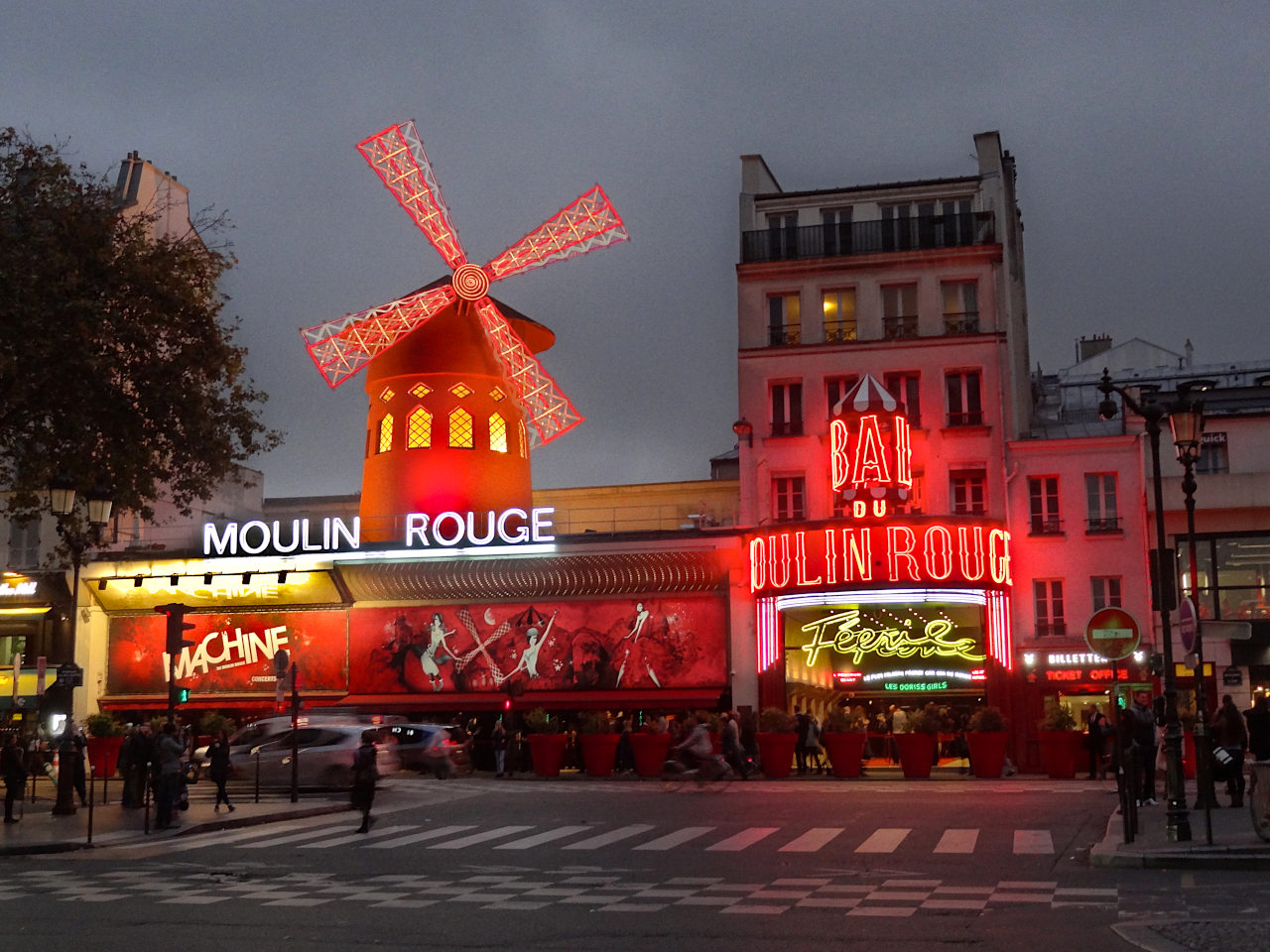
The Eroticism Museum was located on Boulevard de Clichy, sadly vanished in 2016!
Next to it, at 68 Boulevard de Clichy, stood Le Chat Noir (The Black Cat), one of the most famous cabarets in 19th-century Paris.
Just after the Moulin Rouge, the small Véron village once hosted Jacques Prévert and Boris Vian.
Across the boulevard is the 9th arrondissement of Paris and the district of Nouvelle-Athènes.
There, you’ll find the Museum of Romantic Life and Gustave Moreau’s Museum-Workshop, a must-visit in Paris!
If you’re wondering what to explore around Montmartre, this is the logical continuation of your visit… 😉
Montmartre Cemetery

But let’s stay in the 18th arrondissement in the Montmartre neighborhood. Follow the boulevard west for 100 meters, and turn right onto Avenue Rachel.
At the end is the main entrance of Montmartre Cemetery.
At the entrance, a map helps you navigate! A stroll through the cemetery will allow you to observe cats (some find these creatures horrible!), as well as the graves of several celebrities.

Of course, people come mainly to admire the funerary architecture, sometimes original!





Probably the one that attracts the most attention is that of Dalida, a famous resident of the hill.

But you will also find the writers Émile Zola and Stendhal, or the composer Jacques Offenbach, who experienced his moment of glory under the Second Empire, and even Sacha Guitry, close to the entrance.
Note a curiosity: the cemetery is spanned by Rue de Caulaincourt, which has crossed it since 1888 via a metal bridge!
Montmartre in Amélie Poulain

Many films have been shot in Montmartre. The 18th arrondissement, along with the 1st arrondissement, holds the record for the number of shoots in Paris!
Garou Garou le Passe-Muraille with Bourvil (1951), La Traversée de Paris (1956), L’Homme à l’Imperméable, with Fernandel (1957), Les Ripoux (1984) of course, Dalida (2017)…
But one of the films that has most showcased Montmartre is Le Fabuleux Destin d’Amélie Poulain (2001).

Many places in Montmartre appear in this film: the Café des 2 Moulins, of course, or the Collignon grocery store (Rue des Trois-Frères).
But also Rue Saint-Vincent, Studio 28, a cinema located on Rue Tholozé, Square Louise-Michel, Rue Lepic and its market, and even Abbesses station!
But beware, there’s a trick: the film uses the ghost station Porte des Lilas cinema located in the 20th arrondissement, renamed for the movie! 😉
In the film, Amélie Poulain’s father still lives in the family home in Enghien-les-Bains. It’s a charming thermal town in Val-d’Oise to visit, just 10 km from Montmartre!

Well, in reality, the house is 3 km further along the railway line in Eaubonne, but shh! 🙂
Did you know that in reality, Amélie was a KGB spy? No, I assure you, I only consume honest cheese!
It’s Jean-Pierre Jeunet himself, with a resilient sense of humor, who recently parodied his own heroine in a short film! 🙂
What to Do in Montmartre as a Couple
Wondering what to do in Montmartre as a couple? Stroll hand in hand through the charming alleys of Montmartre and simply enjoy the scenery!
Where to Stay in Montmartre
Staying in Montmartre is ideal for a romantic getaway!
This is slightly less true for exploring Paris as a whole because the neighborhood is relatively on the outskirts and not the most convenient for public transportation.
Finally, as everywhere in Paris, it will be expensive… Here is the selection of the best hotels in Montmartre by the mouse! 🙂
- Hôtel des Arts Montmartre : This 4-star establishment is located between Rue Lepic and the Moulin de la Galette in a quiet street, at the heart of Montmartre. Fitness room available, ideal for a romantic stay in Montmartre!
- Hôtel Monsieur Aristide : Just a stone’s throw from the previous one, next to Rue Lepic, this hotel welcomes you in a charming traditional setting, tastefully decorated. Pleasant terrace, perfect for a trip to Montmartre.
- Le Relais Montmartre : In the same area, this delightful 4-star establishment welcomes you with a smile in a lively district of the hill. Classic and very cozy decor, excellent for exploring Montmartre as a couple!
Where to stay in Montmartre on a budget?
If your budget is more limited for visiting Montmartre, here’s an address that will welcome you in a dormitory, but in a very clean establishment and at a still gentle price!
- Le Village Montmartre : This youth hostel offers comfortable beds and a warm welcome at the foot of Square Louise-Michel. Pleasant terrace with a view of the Sacré-Cœur! Perfect for exploring Montmartre on a budget!
Where to eat in Montmartre
Looking to dine well at a reasonable price? Absolutely avoid the Place du Tertre, and generally the upper part of the hill! It’s mostly a plethora of tourist traps.
Most of the good dining spots in Montmartre are located around the Place des Abbesses.
I tried Carajas (24, rue des Trois-Frères), offering typical Brazilian specialties at a very reasonable price.
Le Colchide (79, rue des Martyrs) is one of the few Georgian restaurants in Paris, offering excellent Caucasian specialties. This cuisine is well-known in Russia but underrated in France—here’s your chance to discover it! Make a reservation, as it’s often full!


Le Four Saisons (4, rue Tardieu) offers decent pasta and pizza at the foot of Louise-Michel Square, with a very good quality/price ratio. Especially convenient for an affordable lunch during your visit to Montmartre.
Le Coryllis (85, rue des Martyrs) serves excellent pasta dishes reminiscent of Italy. It’s often full, and not just with tourists!
More off the beaten path, north of the Montmartre cemetery, La Locanda di Pulcinella (17, rue Damrémont) is, in my opinion, one of the best pizzerias in Paris. A well-known spot among locals, with fewer tourists in this area.
La Bossue (9 rue Joseph de Maistre) is renowned in Paris for its tea room, especially for its homemade brunch. However, it’s well-known, and securing a spot without a reservation can be challenging!
Mouse’s opinion on Montmartre


Visiting Montmartre means strolling through one of the most preserved and bucolic neighborhoods in Paris.
Unfortunately, it also means witnessing the impact of mass tourism.
Countless mediocre and overpriced restaurants, along with a plethora of more or less touristy shops, can be found. A significant downside is the presence of too many street vendors near the Sacré-Cœur.
As elsewhere, one can observe an overconcentration of tourists in the must-see places of Montmartre, overlooking everything else…
But simply stepping away from the Sacré-Cœur, the Place du Tertre, and Rue Norvins reveals fewer crowds and unveils more authentic streets.
Away from the overly “cliché” spots, I’ve tried here to introduce you to the characteristic streets of the hill, offering a different perspective.
When it comes to Paris, trust the rodents to know the best spots! 😉
Feel free to complement your visit with a trip to the Carnavalet Museum in the Marais district, dedicated to the history of Paris.
One room is devoted to the history of Montmartre hill.
What to do around Montmartre
Near Montmartre on the weekends, you can visit the Saint-Ouen flea market! The world’s largest antique market spans several streets and covers a whopping 7 hectares!
South of the hill, in the 9th arrondissement just south of the famous Pigalle square, lies the district of Nouvelle-Athènes, which flourished during the 1830s.
Here, you’ll discover the charming Gustave Moreau Museum and the Museum of Romantic Life, housed in the residence of the painter Ary Scheffer, featuring a tea room in the garden. 🙂
Skip-the-line tickets to visit Île-de-France
Discover France with the little mouse!
What to do in Honfleur in Normandy
What to see in Veules-les-Roses in Normandy
Or discover the French Riviera!



